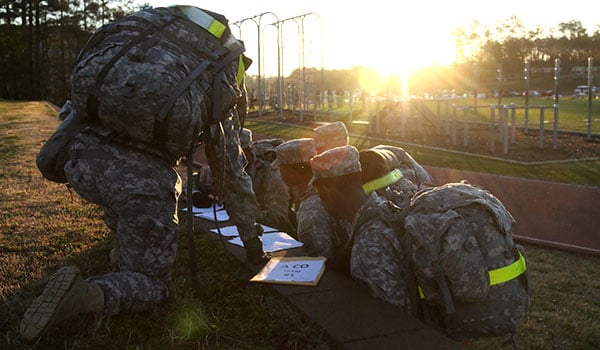
Branch Command Sergeant Major / By CSM Eric C. Thom: Before you are a leader, success is all about growing yourself. When you become a leader, success is all about growing others. – Jack Welch

Soldiers with the 122nd Aviation Support Battalion, 82nd Combat Aviation Brigade, look over notes during the second annual Atlas Warrior Competition, Fort Bragg, NC, March 12, 2015. / U.S. ARMY PHOTO BY CPT ADAN CAZAREZ, 82ND CBT. AVN. BDE.
We all know that the Army’s definition of Leadership is “the process of influencing others by providing purpose, direction and motivation to accomplish the mission and improve the organization.” But why do your Soldiers follow you? The simple truth is it is either commitment or compliance.
Before I go any further I should probably define the difference between commitment and compliance. Being committed means you willingly act for a higher purpose, something greater than yourself. Being compliant means you act based on the leader’s positional power. Let’s face it: in a low-threat environment, either one will work. The problem we run into is, by the nature of our profession we do not always live and work in a low-threat environment, and compliance will only get us so far. Commitment by the members of the organization is what will give us the advantage in a high-threat environment.
Nurturing Commitment
Your willingness to act for a higher purpose does not come naturally. That commitment comes through belief and trust, and that has to be earned. You must do certain things to earn that trust. You have to lead by example. You have to communicate effectively both up and down the chain of command. You have to get results. You have to create a positive environment that fosters esprit de corps, and become a learning organization not afraid to make mistakes. You have to be a steward of the profession, and you have to prepare yourself and develop others. If this describes you and your organization, then read no further as you’ve got this. (I think the CWOB has some interesting points in his article.) However, if there is room for improvement in any of these areas, then I suggest you continue on. There might be something here for you or your organization.
Does leadership come easier to some than it does to others? Sure, but let’s not forget our definition – leadership is a process, and a process can be taught, it can be learned, and as you learn and exercise this process your mastery of it will improve; and that is why I am writing this.
The Department of the Army Inspector General’s office recently completed a six-month survey on Army Leadership Development (Inspection No. 2015-01). The following is a paraphrase of their findings. The inspection found that in general, commanders experienced challenges with balancing and integrating leader development with mandatory training requirements. While brigade and battalion command teams understood supporting leader development guidance, company command teams were still learning how to build successful leader development programs.
Does it surprise anyone that the first level of command is having issues determining what a priority is when everything is somebody’s priority? So let’s make this a little simpler.
Leader Development Principles
The Chief of Staff of the Army has listed Leader Development as his number one priority so it should at least be in your top three. I am not going to just state the obvious and not provide a way ahead. I will not tell you that this is “the way” to learning and executing leadership. However, if you want to be a better leader and just don’t know where to start, let me suggest a way. First, you have to know the terms of reference, and ADP and ADRP 6-22 “Army Leadership” are a great place to start. Just as important are ADP and ADRP 7-0 “Training Units and Developing Leaders.” This is where the Army’s principles of leader development are found.
- Lead by example.
- Develop subordinate leaders.
- Create a learning environment for subordinate leaders.
- Train leaders in the art and science of mission command. (ADP and ADRP 6-0)
- Train and develop adaptive leaders.
- Train leaders to think critically and creatively.
- Train your leaders to know their subordinates and their families.
After reading these (it will not take you long, as ADPs are about 10 pages), I recommend going onto the Army Training Network. It has a Leader Development tab that if selected will provide a wide variety of useful links. If you are not sure how to develop your own program, I suggest starting with the Leader Development Improvement Guide. It provides a fairly comprehensive breakdown on the process. Each of you is at a different point in the Leadership pendulum, but there are a variety of topics and examples here that will assist in most programs. You just have to want to improve and put in the time. Remember the more you exercise and assess your skills the better you as a leader and your leader development program will become. So you can complain about how the system is broken, or you can fix it.
I do not have a statistic for you on this, but I am willing to wager that the leaders who work to improve their leadership and leadership development programs have a far greater percentage of committed team members, while the leaders happy with the status quo have more compliant team members.
As always, it is my honor to serve as your branch CSM.
Above the Best!
CSM Thom
This email address is being protected from spambots. You need JavaScript enabled to view it.
CSM Eric C. Thom is the command sergeant major of the Aviation Branch and the U.S. Army Aviation Center of Excellence, Fort Rucker, AL.










